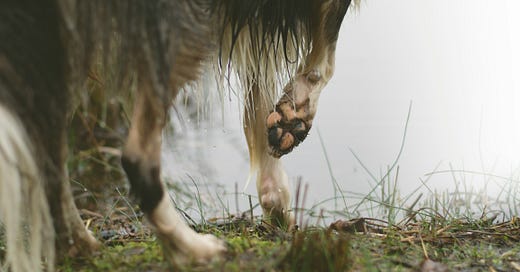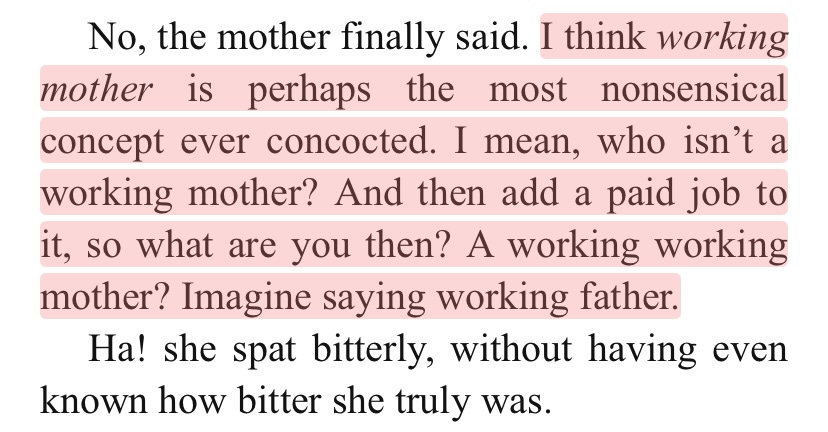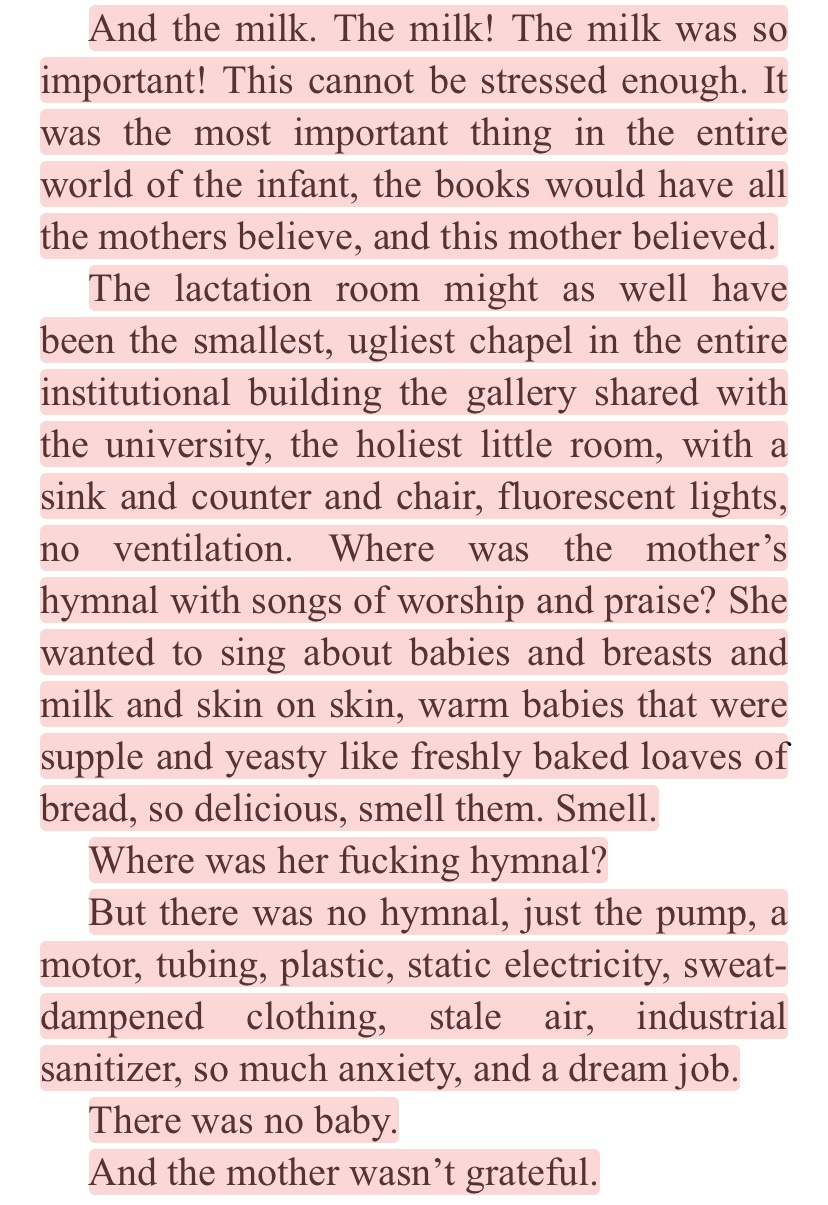“My favorite superstition is the one that says more women deliver during a full moon than at any other time of the month. Transforming into mothers instead of wolves. Howling like wild things.”
—Danielle Valentine,
Delicate Condition
Nightbitch isn’t the kind of book I should like. With a blood-red cover centering an American Meat Institute photo1 of a woman’s hands cradling three raw steaks, coupled with lyrical prose about the struggle of motherhood for the modern woman, I’m guessing most child-free vegans who gorge on commercial horror would pass. But I couldn’t resist.
The unnamed protagonist in Rachel Yoder’s debut novel—referred to simply as “the mother” or “Nightbitch”—suspects she’s turning into a dog2 as she struggles through a variety of issues new mothers often experience, from the inability to maintain basic hygiene to giving up her dream job at an art gallery. Cut into three parts, each is stuffed to the gills with metaphors about motherhood’s connection to our primal nature, but I found three others beneath the skin: breastfeeding and the divine status of dairy and mothers; meat and the normalization of animal cruelty; and zoanthropy3 and the false freedom of being another animal.
Part One: Milking It
If you were to drive along any road in Wisconsin, the bottom of nearly every license plate would remind you that the state is “America’s Dairyland.” Politicians wax poetic about their hard-working dairy farmers, and sports fans wear giant cheddar cheese wedges on their heads. But the mothers who make the milk are excluded.
To be a mother in the dairy industry is to be childless. After growing a life inside your body for nine months, you’d have less than a day with your newborn before they were taken.4 All that work—the emotional labor, the physical labor—and you’d never see them again.
Nightbitch has no knowledge of this, but she meditates on what it means to be a working mother:
Exhausted from working (as a mother) and working (a paying job), and unable to entrust another person for her son’s care, she quits her career to commit to motherhood full-time. She later wonders, as she laments the successful life she’s lost and resents her family for causing that, “without [her son], did she even exist at all?”
Do dairy cows exist? Can they be called mothers if they take no part in mothering their children, only in mothering the humans who suckle their milk instead? The cows who are perpetually either pregnant with new babies or lactating to feed their prior ones exist solely on this earth for the biological products of motherhood they make, yet are prohibited from experiencing the joys, and pains, of all other mothers permitted to be wild or free.
Nightbitch’s mother told her once, “It’s called labor because it’s hard work.” But work implies some reward, either in the form of monetary compensation or emotional validation that something meaningful has been accomplished. Nightbitch’s turmoil over the course of this story culminates in the fusion of her desire to create art and her work as a mother, by putting on shows in her canid form. As she rips apart rabbits in each performance, she channels “the brutality of motherhood, how a child’s first act is violence against the woman who created it.” But if a mother survives that act of violence, and all the suffering that follows it, without any sort of payment, other than to simply keep on working and existing, what’s the point?
Nightbitch’s description above of pumps and tubing, of her sacred milk feeding a machine rather than her baby, could come from the perspective of any dairy mother—with a splash more feces and despair. Yet Nightbitch can, and does, choose to give up the sterile lactation rooms at her art gallery in favor of breastfeeding her son whenever he wants it. That bond between a hungry baby and his providing parent is something virtually no mother cow, nor child cow, on the face of this planet has ever experienced.
There is no chapel for mothers, despite the divine wonders they create, despite their hard, unacknowledged work. Nightbitch wars with this in her mind, thinking both, “At times she terrified herself, wondering if she was a god, if being a mother was one way of being a god,” and, “Her sense that society, adulthood, marriage, motherhood, all these things, were somehow masterfully designed to put a woman in her place and keep her there.” The god-like ability of, and expectation for, mothers to not only birth new life but to nurture it into maturity is rarely acknowledged or compensated for the work it is. It’s almost too holy to touch, an imaginary pedestal on which each mother stands alone, at a height that all other mothers struggle to reach.
The divinity of motherhood is sucked out, packaged, and sold in the dairy industry, little bits of a holy mother’s milk in our mouths. Commodified and subsidized so everyone can share the fruits of her labor. Like the climax of Darren Aronofsky’s film Mother! the whole is ripped to pieces, destroying every part of motherhood and childhood so we may hold a bastardized, pasteurized, diluted version of the nectar taken from the mouths of babes.
Part Two: Feeding Frenzy
Like a god, mothers make children in their own image, intentionally or not. As Nightbitch exhibits more canine characteristics, her son follows suit. Carrying around a raw steak in his mouth, sleeping in a crate, walking on a leash, biting a toy duck to hear it squeak—he’s learned that mommies kill and eat animals, so he wants to do that, too. His mimicry leads him to ask after she kills the family’s cat in a humiliated rage, “Eat it?” To which she responds, “Kitty isn’t for eating.” Though she has killed many animals by this point—both by her own hand and by her wallet—she’s trained him to see some animals as food and others as slightly more valuable.
Though never expressed directly, an implicit connection is made throughout the novel between birth and death. The beginning and ending of life, the first and last things anyone ever experiences, are two sides of the same coin. The process of birthing life—“To push a thing from the most private part of yourself. To have it scream upon its arrival”—is much like the process of eating life, in which the thing screams first before being pushed into a part of yourself.
“The grocery store is a locus of oppression,” she thinks earlier, as her son watches the tank of lobsters awaiting sale in the store’s seafood section. A fleeting thought, she moves past the captive crustaceans and buys “upward of ten pounds of red meat.” The grocery store may be a locus of oppression, but it’s an oppression she hungrily supports to feed her dog-self and her pup.
Any disgust or dismay at the thought of killing animals is dismissed by the book’s end. A beast herself, she relishes the violence. She tries to convince herself that vegetables are good, “civilized” food, but they come to represent the toil she experiences as a mother robbed of the creative life she’d hoped for. It’s only by embracing the carnal pleasures of crushing skulls in her mouth, of blood gushing down her throat, of silencing panicked yelps, that she can become the self-actualized version of herself, a mother-artist displaying her primal motherhood for all to see.
“[I]f being a mother was one way of being a god,” then eating meat is another. This story concludes that Nightbitch is like a god, and as such can bring about life or death with no moral consequence. Indeed, these acts are presented as utterly amoral, and to question them is to question the holiness of motherhood itself. “We are at base animals,” she says, “and to deny us either our animal nature or our dignity as humans is a crime against existence.”
Her wanton eating of cows and pigs at home, and her bloody hunting of bunnies in her performances, exhibits the brutality of motherhood, of life, by projecting that brutality onto others. In order to shed her own problems, she thrusts them upon other animals.
Part Three: Barking Mad
The freedom Nightbitch experiences upon accepting and embracing her doggish form depends upon devouring the freedoms of her animal kin. Though she kills many animals by tooth and by claw, the animals she eats in her human form exist only as remains. They live shackled to the humans who reshape their bodies, impregnate them, take their babies, and kill them—manipulating their biology to maximize production of fat, muscle, skin, hair, and milk or eggs. There is no freedom on an animal farm.
Nightbitch’s zoanthropy is nothing but a domesticated illusion. To be a dog is to be tamed, a once-wild nature called to heel over millennia of artificial selection. Her feral cravings for raw, bloody flesh, for the untameable “thrust of life, life, life,” draw to mind images of wolves racing through evergreen forests rather than Nightbitch’s shitting on the neighbor’s lawn and tumbling down suburban streets on hands and feet. Nightbitch has not grown, she has not evolved; she has simply switched from the domesticity of personhood to the domesticity of doghood, bringing along the mundane horrors of motherhood into her next phase of life.
Being fully present in her canine body presents nonhuman animals as mystical beings, vessels of an uninhibited nature. Utterly pure, they exist solely in their physical bodies, as if a mother protecting her pup is nothing but instinct, reflex. Rational thought recedes as biological drives take over; emotions conglomerate into the base desires to eat, fuck, and protect.
Presumably plant-eating animals feel the same devotion to their children as meat-eating ones, yet I wonder if women turning into squirrels or rabbits would exhibit the same primal violence as Nightbitch. Though the human body is physiologically herbivorous, we’ve flouted evolution in favor of wearing the weapons of predators.
Epilogue: Bucking Wild
Intentionally or not, most readers approach Nightbitch’s story from a speciesist perspective, in which humans are a god-like, unavoidable force of gravity pressing down upon all other animals. The premise presumes a permanent severance between our primal, primordial nature and the modern human mind, that every other species lives only in the moment, pursuing basic biological drives while humans have lost that part of ourselves. It’s only by physically transforming into another species that we can find it again.
But humans are not so different. We play a unique role on this planet, yet our minds remain stubbornly animalistic. Nightbitch (the book itself) proves that. The stories we tell serve as lions’ roars, starlings’ murmurations, bees’ hivemind: a signal, a strategy, a lesson for one another about how to survive in this world—like how motherhood can beat us down if we choose to battle through it alone.
Though we do not speak the tongue of cows, we understand from each mother’s mournful cries that she feels the same divine connection to her baby as Nightbitch. We may have domesticated ourselves to a point of isolation from the wild world, but we retain intrinsic connections to it in the way we interpret and interact with life. Once we understand that, we understand that to be human is to be animal.
On my mind: Good Boy (2022)
A very different kind of canine transformation, Good Boy is a Norwegian film in which a young woman begins dating a young man who shares his home with a person that dresses, acts, and lives as a dog. The movie is a little slow, but I’m endlessly fascinated with how our concept of personhood shifts when humans take on animal identities.
As I was writing this, I happened to stumble across this post by
using the exact same image. Freaky!I thought it was weird that her mind immediately goes to dogs rather than werewolves, but there are actually more reports of clinical kynanthropy (the belief one can turn into a dog, 19 cases) than clinical lycanthropy (the belief one can turn into a wolf, 13 cases) since 1850. Dr. Brian A. Sharpless—a longtime vegetarian—dedicates an entire chapter of Monsters on the Couch: The Real Psychological Disorders Behind Your Favorite Horror Movies to this phenomenon.
Zoanthropy is the generic term for the belief that one can turn into another kind of animal.
Kathryn Gillespie writes in The Cow with Ear Tag #1389, “The USDA Animal and Plant Health Inspection Service documents that roughly one-fourth of dairy farms in the United States remove calves within one hour of birth and more than half (57.5 percent) separate calves and cows between one and fourteen hours after birth.” You can read the USDA report here.







Thank you for sharing such an insightful exploration of "Nightbitch." I found the themes of motherhood's demands and personal aspirations, as well as social expectations very thought-provoking.
Interesting perspective, a lot of things I’ve never considered before in here. Could you explain more about how humans are "physiologically herbivorous?"